|
|
 |
|
|
The Blitz Buggy – CMP 3-ton Lorry
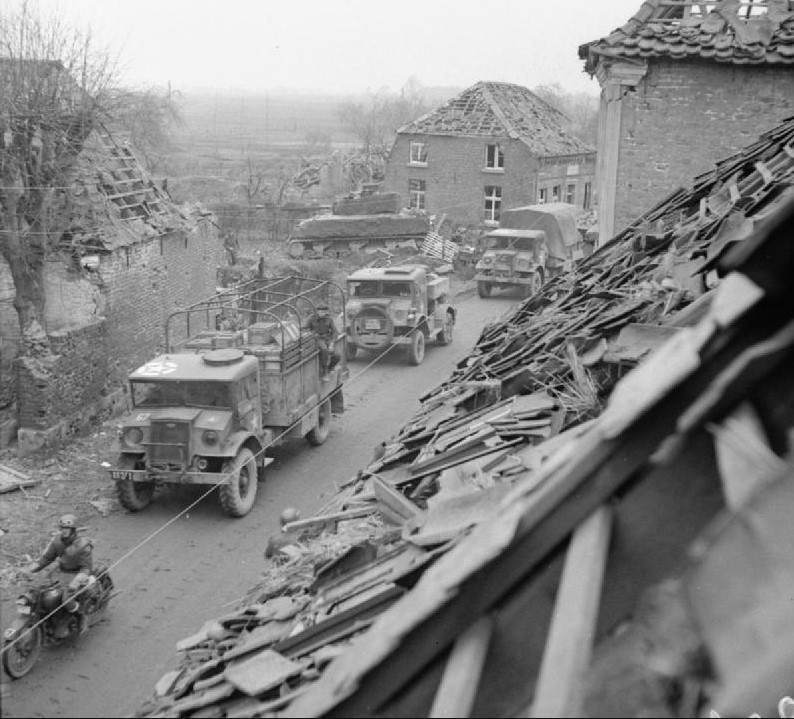 |
The Blitz Buggy – CMP 3-ton Lorry
By Adam Brooker
You could argue that battles are won more by the successful delivery of supplies, men and materials, than by the bravery of men and the quality of their arms. Without fuel, ammunition, supplies and spare parts, almost all armies will grind to a halt and without adequate transport troops will fail to reach an objective before the enemy. In WWII trucks and lorries were the lifeblood of most campaigns, allowing the fuel, food and ammunition to get from the ports and supply dumps to the soldiers in the field much faster than horses and not constrained to rails like trains.
|
|
Canada produced more than 800,000 trucks and light-wheeled vehicles for the British Empire during WWII, with Canadian factories GM (Chevrolet), Chrysler, and Ford producing the bulk of them. These were then shipped all over the world to the battlefields of the Pacific, North Africa and Europe. In fact, it is regarded by many as one of the greatest contributions of Canada towards winning the war by essentially putting the British and Commonwealth Army ‘on wheels’, and by the end of the war producing one truck for every three soldiers in the British Army.
|
|
The CMP truck, or Canadian Military Pattern truck, was essential to the Allied victory in North Africa, with the British 8th Army fighting and moving almost exclusively in CMP trucks and the advance through Sicily, Italy and France also on the back of these hardy and well-liked trucks. The CMP truck began as a 15 hundredweight (cwt) or ¾ ton US 4x4 truck that started its design before the war when in 1937 Canada was asked by Britain to start producing vehicles for the British Army, given Canadian forces would be most likely again asked to work closely with the British, and the rise of Hitler in Germany suggested war was brewing in Europe.
|
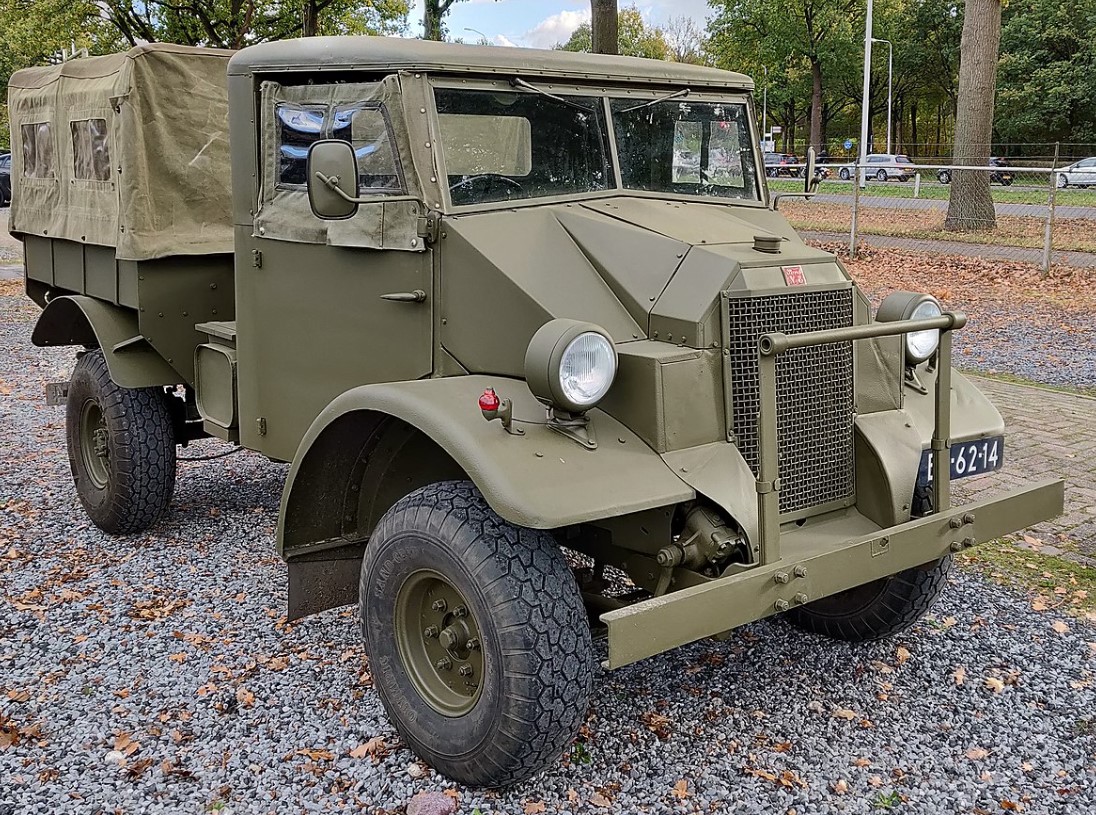 |
|
A Ford F8 CMP Truck 4 x 2 8 cwt – with No.11 Cab
|
|
Canadian Defence officials asked the Canadian subsidiaries of Ford and GM to design a prototype 15 cwt 4x4 Truck similar to the Morris CS8 truck that had just been accepted into British service. In 1938 and 1939 they were asked to also develop a heavier 4x4 version and a 6 x 4 version as an artillery tractor. By 1939 plans had been prepared for the mass production in Canada of a range of military vehicles based on fairly strict CMP British specifications, and when the war finally started in September 1939, Canada's large automotive industry was quickly switched over to military vehicles that out produced German manufacturing and by the end of the war was producing more trucks than Germany, Japan and Italy combined.
|
|
The war forced remarkable cooperation between companies that would typically be bitter rivals, with Ford and GM (Chevrolet) producing most of the CMP trucks and even having interchangeable components between vehicles of different manufacturers. The two companies quickly ramped up production as both had reserve capacity that had been idle since the Great Depression, and by the end of the war, both had produced around 410,000 CMP trucks. Canada's military truck production focused predominantly on a broad range of medium-rated vehicles, with jeeps and larger trucks with over 3 tons of capacity required by the Canadian Army being purchased from outside suppliers like the United States.
|
|
When the British Army lost most of its equipment during the Dunkirk evacuation, the Canadian CMP trucks were the logical source to start replacing the light vehicle losses. Soon Canadian trucks were being sent to England, North Africa, India as well as the other colonies of Australia, New Zealand and South Africa. Trucks were taken fresh off the production lines, broken down, boxed up, and shipped by boat, to then be reassembled when they arrived.
|
|
CMP trucks were generally produced in right-hand drive, despite Canada being left-hand drive because they were made to British specifications. Eventually, over 90 different types of CMP trucks were produced on twelve different chassis, including specialised vehicles such as wireless vehicles, ambulances and mobile workshop trucks.
|
|
There were 3 different types of cabin designs, the first being the Ford-built No.11 cab, followed by the No.12 design. These were essentially the same with the main difference being that the No.12 had a two-part radiator grille and its upper part was opened with a bonnet which was known as the "Alligator cab". The No.13 design was the most produced version from 1941 to the end of the war and had two flat panes of the windscreen angled slightly down to minimize the glare from the sun and to avoid strong reflections that could be seen by aircraft.
|
|
All CMP trucks had a short “cab forward” configuration that gave them the distinctive pug-nosed profile, which was a design requirement of the British specifications, to allow more efficient transport via ship. Despite the initial design being only for 15 cwt, the design was eventually increased to be able to haul 60 cwt or 3-ton, with the 3-ton trucks often being designated 60 cwt CMP trucks or 3-ton Lorries. British standard load capacities of 8 cwt (400kg), 15 cwt (760kg), 30 cwt (1525kg) and 60 cwt (3050kg), roughly correspond to American loads of ½, ¾ ton, 1.5 and 3 short tons respectively.
|
|
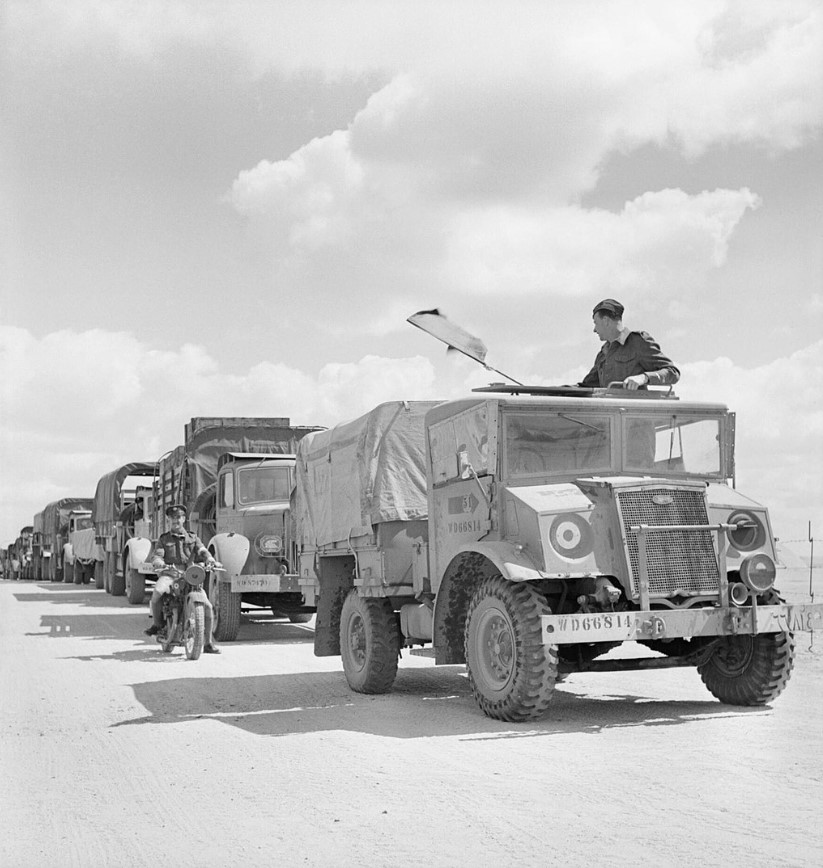
|
|
A Blitz Buggy (Ford F15 4x2 15 cwt) leading a convoy in North Africa
|
|
I can’t help but add, as an Australian, that in Australian service the CMP truck with almost exclusively the No.13 cab was known as the Chev Blitz or the Ford Blitz, but I wasn’t sure where this moniker came from. It seems during the desert war in North Africa the Australians started calling their CMP trucks Blitz Buggies or Desert Blitz, and after capturing several German Opel Blitz trucks both the Aussies and Pommies referred to all trucks as Blitz, and the name seems to have stuck with many Australians growing up and knowing these as a Chevy or Ford Blitz. Not sure if this is true, but it sounds plausible.
|
|
The trucks in the desert were most likely the 15 or 30 cwt trucks with the shorter wheelbases, but the cabs on the heavier 60 cwt trucks are exactly the same so would look identical unless you knew any better. As all the CMP trucks have a very distinctive look, it's easy to see why they were all given the same nickname.
|
|
Talking about identifying trucks, it looks like the CMP 3-ton Lorry that is coming out again with the British Bulge book is most likely a Chevy C60L / Ford F60L 3-ton (60 cwt) Truck with the longer wheelbase. The 3-ton Lorry with the shorter wheelbase would be the Chevy C60S / Ford F60S, with a shorter rear cargo tray.
|
|
They were also used as a base for other light vehicles, such as the Humber and Otter LRCs, which were based on a Chevy C15 truck. The Ford Lynx Scout car was the hull of a Dingo Scout car on a Ford CMP chassis. The Canadians even produced an armoured truck called the C15TA Armoured Truck, which was based on a Chevy C15 15 cwt CMP truck, which was to be a Canadian version of the M3 (White) Scout Car.
|
|
I call these trucks and gun transports ‘Battlefield Bling’; you don’t use them very often except in big games where you need to move your guns or infantry far quickly, but they look awesome when you lay your force out on the table. For me, adding them is one of the little touches that really add to a force, like sculpted Objective Markers, matching dice and tin sets, and all the transport options. When I play in tournaments, I will often bring the unit transports if I have them, to put them out when Armies on Parade came around just to show off the Force with all the options.
|
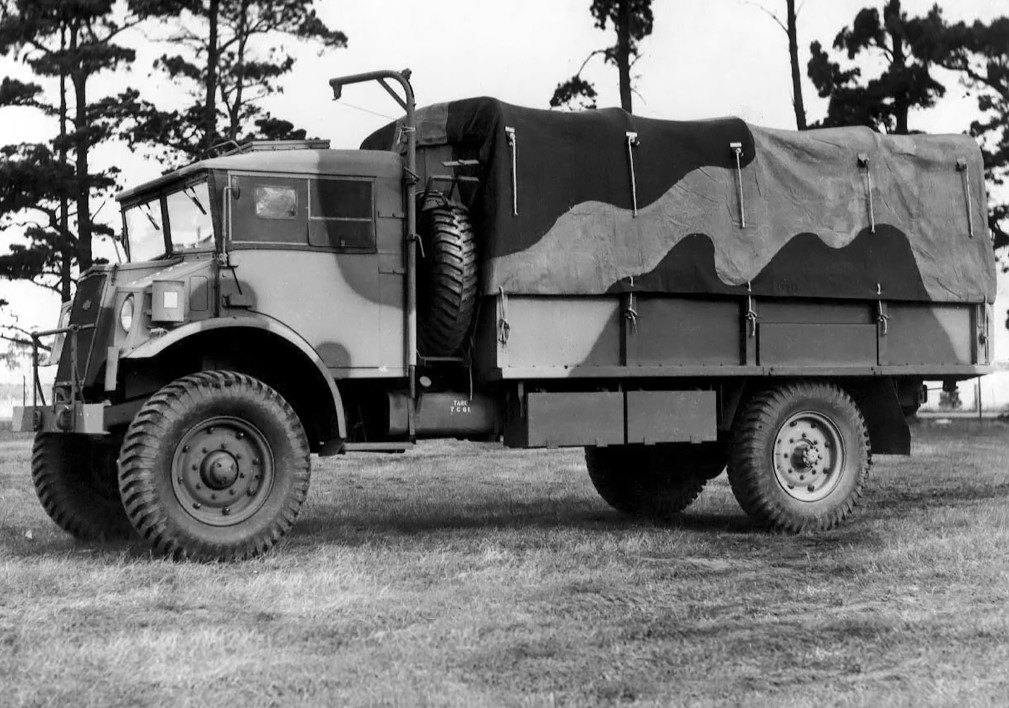 |
|
A Chevy C60L 4x4 60 cwt (3-ton) Truck with No. 13 cab
|
|
Using them in game is pretty simple, the rules are located in the Command Card deck for British Bulge or on Forces of War online, which is very convenient, and if you haven’t tried it yet I recommend it. These are the same option from the British D-Day book, so a 1-point upgrade to the Kangaroo Rifle Company HQ, Kangaroo Rifle Platoon, and 25 pdr Field Battery.
|
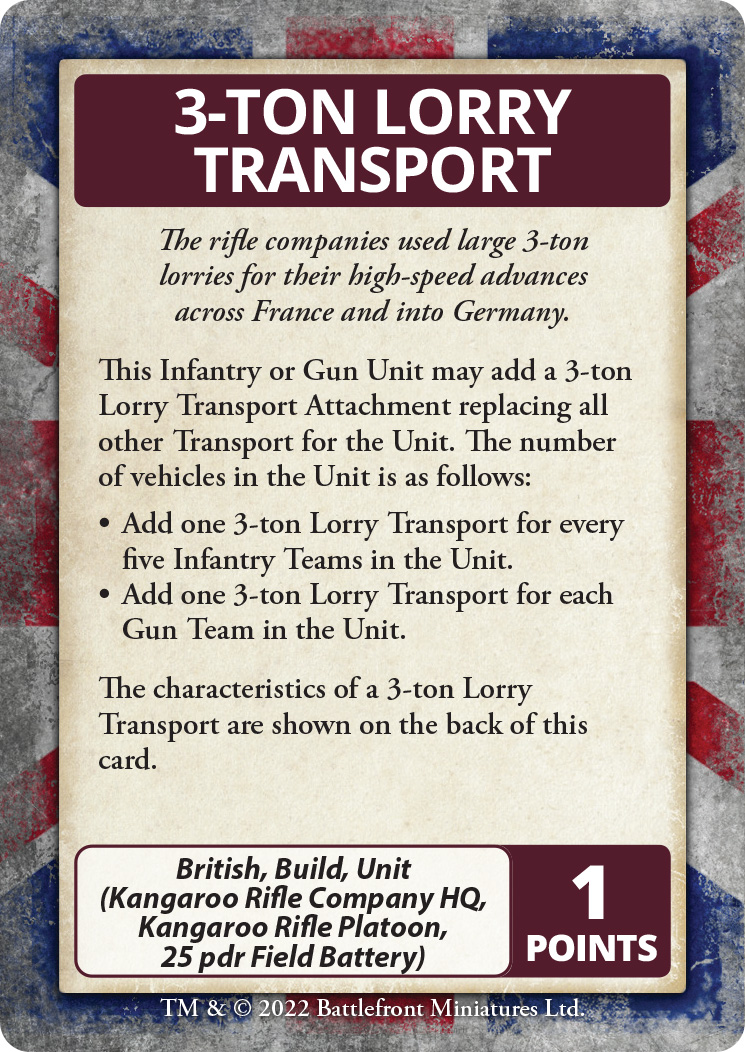 |
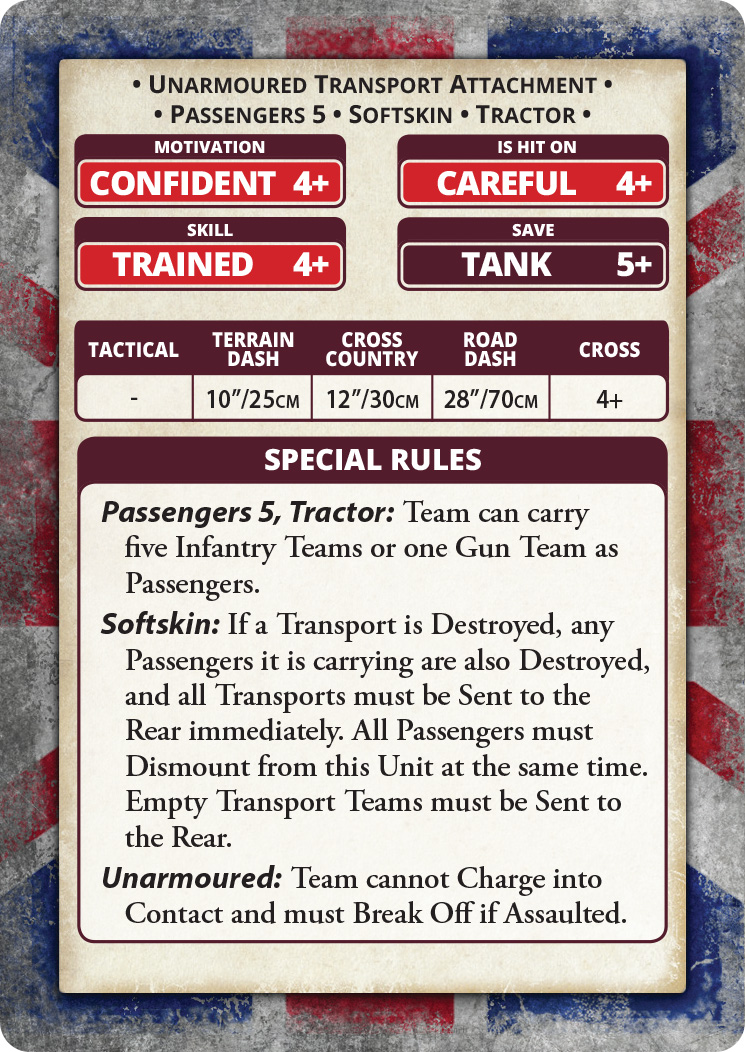 |
|
It will give you either one 3-ton Lorry per 5 infantry stands or one 3-ton Lorry per gun team, so you will need two trucks per Rifle Platoon or four trucks per 25 pdr gun team. They are best used via roads, as they have a 28” Road Dash which is much faster than trying to move the units on foot, especially the gun teams. But they only have a 12” Cross Country Dash, a 10” Terrain Dash, and a 4+ Cross Check, so trying to move these through difficult terrain will be risky and slow.
|
|
They have a 4+ to hit, but only a 5+ tank save, which means if you are hit you are most likely destroyed. Also, the Softskin rule means that if a transport is destroyed by enemy fire or in assault, any passengers it is carrying are also destroyed, the surviving infantry or gun teams will dismount and any remaining transports in the unit are sent to the rear (off the table). So if you do use these transports in game to quickly move up your troops make sure the enemy cannot fire on them, as you will take heavy casualties if you are hit.
|
|
They really do add that little bit of extra to your Force, but I do like that in V4 they are now in the optional Command Card section, so you can take them or leave them. But I will be definitely taking them.
Happy Gaming,
Adam
|
|
|
|